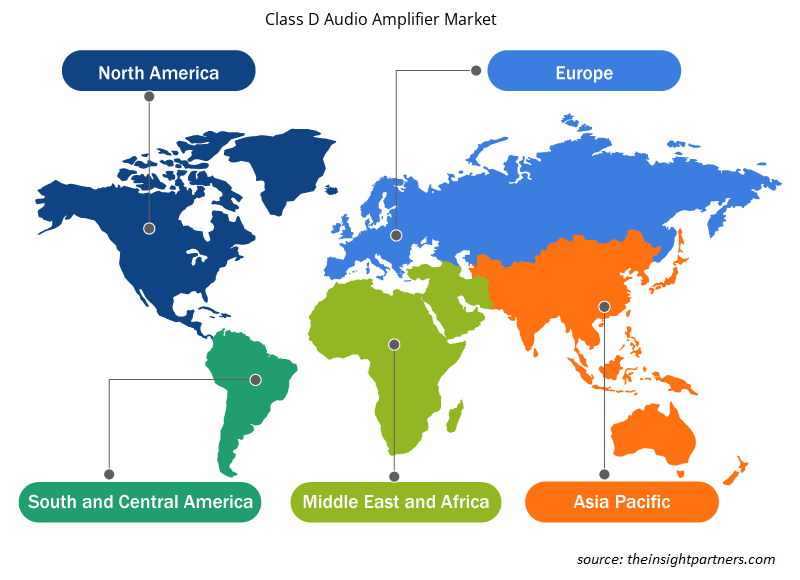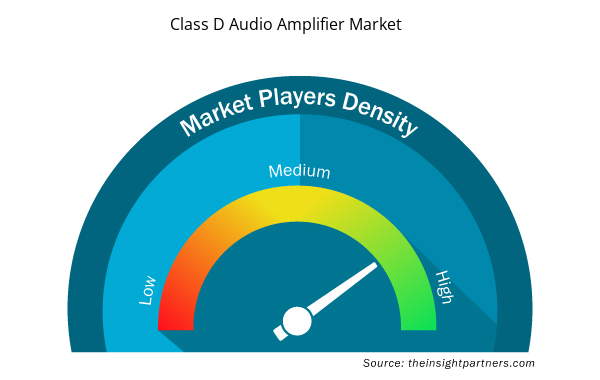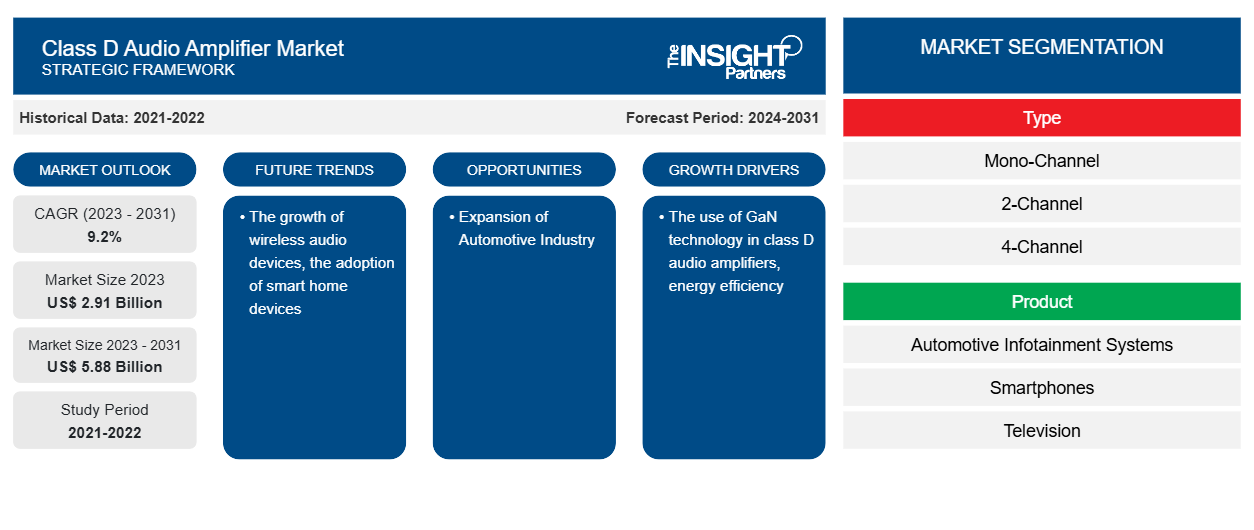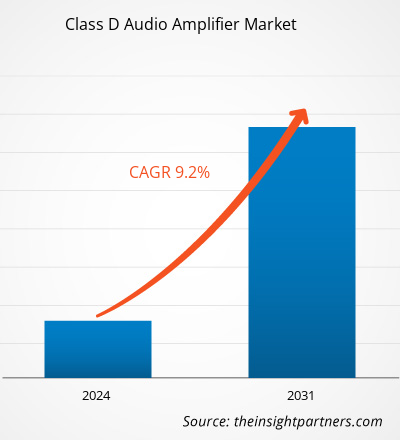Der Markt für Audioverstärker der Klasse D soll von 2,91 Milliarden US-Dollar im Jahr 2023 auf 5,88 Milliarden US-Dollar im Jahr 2031 anwachsen. Der Markt wird zwischen 2023 und 2031 voraussichtlich eine durchschnittliche jährliche Wachstumsrate von 9,2 % verzeichnen. Das Wachstum bei drahtlosen Audiogeräten und die Einführung von Smart-Home-Geräten dürften weiterhin ein wichtiger Trend auf dem Markt bleiben.
Marktanalyse für Audioverstärker der Klasse D
Im Wesentlichen ist ein Audioverstärker der Klasse D ein Schaltverstärker, der manchmal auch als PWM-Verstärker bezeichnet wird. Große öffentliche Durchsagen, Sprachverstärkung und Live-Sound-Systeme verwenden zunehmend die Technologie der Klasse D anstelle der traditionell umständlichen, schweren und ineffizienten Leistungsverstärker. Verstärker der Klasse D können auch gut für Bluetooth -Kopfhörer geeignet sein, während aufgrund des relativ geringen Lautstärkebedarfs auch andere Verstärkertypen in diesem speziellen Szenario verwendet werden können. Verstärker der Klasse D sind auch in einer Vielzahl anderer Produkte zu finden, beispielsweise in Stereoverstärkern und tragbaren Kopfhörerverstärkern.
Marktübersicht für Audioverstärker der Klasse D
Die Hauptfaktoren, die die Nachfrage nach Audioverstärkern der Klasse D antreiben, sind unter anderem der zunehmende Einsatz in elektronischen Geräten der Unterhaltungselektronik wie Lautsprechern, Bluetooth-Audiogeräten und Heimkinos. Die steigende Nachfrage nach Infotainmentsystemen für Autos treibt die Marktnachfrage weltweit ebenfalls an.
Passen Sie diesen Bericht Ihren Anforderungen an
Sie erhalten kostenlose Anpassungen an jedem Bericht, einschließlich Teilen dieses Berichts oder einer Analyse auf Länderebene, eines Excel-Datenpakets sowie tolle Angebote und Rabatte für Start-ups und Universitäten.
- Holen Sie sich die wichtigsten Markttrends aus diesem Bericht.Dieses KOSTENLOSE Beispiel umfasst eine Datenanalyse von Markttrends bis hin zu Schätzungen und Prognosen.
Markttreiber und Chancen für Audioverstärker der Klasse D
Einsatz der GaN-Technologie in Audioverstärkern der Klasse D soll den Markt begünstigen
Silizium-MOSFETs wurden als De-facto-Transistortechnologie bei der Entwicklung von Class-D-Verstärkern verwendet. Die GaN-Technologie ermöglicht nun die Entwicklung einer neuen Verstärkergeneration, die zu erheblichen Verbesserungen bei Produktleistung und Audioqualität führen wird. Die schnelle Schaltgeschwindigkeit von Silizium-MOSFETs begrenzt die Audioleistungsoptionen, die den Entwicklern zur Verfügung stehen. GaN-Transistoren haben eine wesentlich höhere Betriebsfrequenz und ermöglichen dadurch sanfte, schnelle Schaltübergänge. Daher umfassen GaN-Class-D-Audiosysteme kleinere, effektivere Audiogeräte mit deutlich besserer Audioleistung. Die Anwendung der GaN-Technologie im Class-D-Audiodesign wird es den Entwicklern ermöglichen, eine neue Welle innovativer Produkte mit verbesserter Energieeinsparung und besserer Audioleistung in neuen, kleineren Formfaktoren zu kostengünstigen Preisen herzustellen.MOSFET has been used as the de facto transistor device technology in the creation of Class-D amplifiers. GaN technology now makes it feasible to design a new generation of amplifiers that will lead to significant advancements in product performance and audio quality. Silicon MOSFETs' fast switching limits the audio performance options available to designers. GaN transistors have a substantially higher operating frequency, enabling smooth, quick switching transitions. As a result, GaN Class-D audio systems include smaller, more effective audio devices with noticeably better audio performance. The application of GaN technology in Class-D audio design will make it possible for designers to produce a new wave of inventive products with enhanced energy economy and better audio performance in new, smaller form factors at cost-effective pricing.
Expansion der Automobilindustrie
Die globale Automobilindustrie ist auf dem Vormarsch. Mit der zunehmenden Vorliebe für hochmoderne Unterhaltungszentren im Auto steigt die Nachfrage nach Audioverstärkern der Klasse D. Mit der Integration von Unterhaltungs-, Navigations-, Kommunikations- und Fahrzeugsteuerungssystemen in nahtlose Benutzererlebnisse bilden Automobil und Infotainment einen entscheidenden Zusammenfluss von Technologien in modernen Automobilen. Durch eine Vielzahl an Bordelektronik und Apps bietet Automotive Infotainment, auch bekannt als In-Vehicle Infotainment (IVI), Fahrern und Passagieren Unterhaltung und Informationen. Es ist eine Integration von Hardware und Software. Audioverstärker der Klasse D bilden einen wichtigen Teil der Audiosysteme im Auto. Somit schafft die zunehmende Vorliebe für verbesserte Infotainmentsysteme Möglichkeiten für das Wachstum des Marktes für Audioverstärker der Klasse D.IVI), provides drivers and passengers with entertainment and information. It is an integration of hardware and software. Class D audio amplifiers form a major part of the audio systems in the car. Thus, the rising preference for enhanced infotainment systems is creating opportunities for the growth of the Class D audio amplifier market.
Marktbericht zu Audioverstärkern der Klasse D – Segmentierungsanalyse
Wichtige Segmente, die zur Ableitung der Marktanalyse für Audioverstärker der Klasse D beigetragen haben, sind Typ, Produkt und Branche.
- Basierend auf dem Typ ist der Markt für Audioverstärker der Klasse D in Monokanal, 2-Kanal, 4-Kanal und 6-Kanal unterteilt. Das Monokanalsegment hatte im Jahr 2023 den größten Anteil.
- Basierend auf dem Produkt ist der Markt in Auto-Infotainmentsysteme, Smartphones, Fernseher und Sonstiges unterteilt.
- Basierend auf der Branchenvertikale ist der Markt in Automobil, Unterhaltungselektronik und Sonstige unterteilt.
Marktanteilsanalyse für Audioverstärker der Klasse D nach geografischer Lage
Der geografische Umfang des Marktberichts für Audioverstärker der Klasse D ist hauptsächlich in fünf Regionen unterteilt: Nordamerika, Asien-Pazifik, Europa, Naher Osten und Afrika sowie Süd- und Mittelamerika.
Nordamerika hält im Jahr 2023 einen bedeutenden Anteil am Markt für Audioverstärker der Klasse D. Nordamerika ist einer der größten Märkte für Unterhaltungselektronik und auch ein bedeutender Automobilhersteller. Länder wie die USA sind die Heimat der weltweit größten Hersteller von Unterhaltungselektronik und treiben so das Wachstum der Region voran.
Regionale Einblicke in den Markt für Audioverstärker der Klasse D
Die regionalen Trends und Faktoren, die den Markt für Audioverstärker der Klasse D im gesamten Prognosezeitraum beeinflussen, wurden von den Analysten von Insight Partners ausführlich erläutert. In diesem Abschnitt werden auch die Marktsegmente und die Geografie der Audioverstärker der Klasse D in Nordamerika, Europa, im asiatisch-pazifischen Raum, im Nahen Osten und Afrika sowie in Süd- und Mittelamerika erörtert.

- Erhalten Sie regionale Daten zum Markt für Audioverstärker der Klasse D
Marktbericht zu Audioverstärkern der Klasse D – Umfang
| Berichtsattribut | Details |
|---|---|
| Marktgröße im Jahr 2023 | 2,91 Milliarden US-Dollar |
| Marktgröße bis 2031 | 5,88 Milliarden US-Dollar |
| Globale CAGR (2023 - 2031) | 9,2 % |
| Historische Daten | 2021-2022 |
| Prognosezeitraum | 2024–2031 |
| Abgedeckte Segmente | Nach Typ
|
| Abgedeckte Regionen und Länder | Nordamerika
|
| Marktführer und wichtige Unternehmensprofile |
|
Marktteilnehmerdichte für Audioverstärker der Klasse D: Auswirkungen auf die Geschäftsdynamik verstehen
Der Markt für Audioverstärker der Klasse D wächst rasant, angetrieben durch die steigende Nachfrage der Endnutzer aufgrund von Faktoren wie sich entwickelnden Verbraucherpräferenzen, technologischen Fortschritten und einem größeren Bewusstsein für die Vorteile des Produkts. Mit steigender Nachfrage erweitern Unternehmen ihr Angebot, entwickeln Innovationen, um die Bedürfnisse der Verbraucher zu erfüllen, und nutzen neue Trends, was das Marktwachstum weiter ankurbelt.
Die Marktteilnehmerdichte bezieht sich auf die Verteilung der Firmen oder Unternehmen, die in einem bestimmten Markt oder einer bestimmten Branche tätig sind. Sie gibt an, wie viele Wettbewerber (Marktteilnehmer) in einem bestimmten Marktraum im Verhältnis zu seiner Größe oder seinem gesamten Marktwert präsent sind.
Die wichtigsten Unternehmen auf dem Markt für Audioverstärker der Klasse D sind:
- Analog Devices, Inc
- INFINEON TECHNOLOGIES AG
- NXP-Halbleiter.
- ON Semiconductor Corporation
- Qualcomm Technologies, Inc.
- STMicroelectronics NV
Haftungsausschluss : Die oben aufgeführten Unternehmen sind nicht in einer bestimmten Reihenfolge aufgeführt.

- Überblick über die wichtigsten Akteure auf dem Markt für Audioverstärker der Klasse D
Neuigkeiten und aktuelle Entwicklungen zum Markt für Audioverstärker der Klasse D
Der Markt für Audioverstärker der Klasse D wird durch die Erhebung qualitativer und quantitativer Daten nach Primär- und Sekundärforschung bewertet, die wichtige Unternehmensveröffentlichungen, Verbandsdaten und Datenbanken umfasst. Nachfolgend sind einige der Entwicklungen auf dem Markt für Audioverstärker der Klasse D aufgeführt:
- Die Infineon Technologies AG hat kürzlich ihre neueste Generation von MERUS™ Multilevel-Audioverstärkern der Klasse D vorgestellt. Mehrere Ökosystempartner von Infineon sind nun bereit, interessierte Kunden bei ihren Design-In-Bemühungen zu unterstützen. Durch die Partnerschaft mit den Experten will das Unternehmen die Einführung neuer und innovativer Technologien vorantreiben. Die Audioverstärker der Klasse D von Infineon ermöglichen eine Hi-Fi-Klangwiedergabe mit einer einzigartigen Klasse-D-Modulation von bis zu 5 verschiedenen Ausgangsspannungspegeln. (Quelle: Infineon Technologies, Pressemitteilung, Januar 2023)
Marktbericht zu Audioverstärkern der Klasse D – Abdeckung und Ergebnisse
Der Bericht „Marktgröße und Prognose für Audioverstärker der Klasse D (2021–2031)“ bietet eine detaillierte Analyse des Marktes, die die folgenden Bereiche abdeckt:
- Marktgröße und Prognose für Audioverstärker der Klasse D auf globaler, regionaler und Länderebene für alle wichtigen Marktsegmente, die im Rahmen des Berichts abgedeckt sind
- Markttrends für Audioverstärker der Klasse D sowie Marktdynamik wie Treiber, Einschränkungen und wichtige Chancen
- Detaillierte PEST/Porters Five Forces- und SWOT-Analyse
- Marktanalyse für Audioverstärker der Klasse D mit wichtigen Markttrends, globalen und regionalen Rahmenbedingungen, wichtigen Akteuren, Vorschriften und aktuellen Marktentwicklungen
- Branchenlandschaft und Wettbewerbsanalyse, einschließlich Marktkonzentration, Heatmap-Analyse, prominenten Akteuren und aktuellen Entwicklungen auf dem Markt für Audioverstärker der Klasse D.
- Detaillierte Firmenprofile
- Historische Analyse (2 Jahre), Basisjahr, Prognose (7 Jahre) mit CAGR
- PEST- und SWOT-Analyse
- Marktgröße Wert/Volumen – Global, Regional, Land
- Branche und Wettbewerbsumfeld
- Excel-Datensatz



Report Coverage
Revenue forecast, Company Analysis, Industry landscape, Growth factors, and Trends

Segment Covered
This text is related
to segments covered.

Regional Scope
North America, Europe, Asia Pacific, Middle East & Africa, South & Central America

Country Scope
This text is related
to country scope.
Häufig gestellte Fragen
The class D audio amplifier market is expected to register a CAGR of 9.2% during 2023–2031
The class D audio amplifier market size is projected to reach US$ 5.88 billion by 2031
The growth of wireless audio devices and the adoption of smart home devices are likely to remain key trends in the market.
Analog Devices, Inc., INFINEON TECHNOLOGIES AG, NXP Semiconductors., ON Semiconductor Corporation, Qualcomm Technologies, Inc., STMicroelectronics N.V., Silicon Laboratories, Inc., Texas Instruments Incorporated, Maxim Integrated, and ICEpower a/s are among the leading payers operating in the class D audio amplifier market.
The use of GaN technology in class D audio amplifiers and energy efficiency are expected to drive the class D audio amplifier market.
North America dominated the class D audio amplifier market in 2023.
Trends and growth analysis reports related to Electronics and Semiconductor : READ MORE..
The Insight Partners performs research in 4 major stages: Data Collection & Secondary Research, Primary Research, Data Analysis and Data Triangulation & Final Review.
- Data Collection and Secondary Research:
As a market research and consulting firm operating from a decade, we have published and advised several client across the globe. First step for any study will start with an assessment of currently available data and insights from existing reports. Further, historical and current market information is collected from Investor Presentations, Annual Reports, SEC Filings, etc., and other information related to company’s performance and market positioning are gathered from Paid Databases (Factiva, Hoovers, and Reuters) and various other publications available in public domain.
Several associations trade associates, technical forums, institutes, societies and organization are accessed to gain technical as well as market related insights through their publications such as research papers, blogs and press releases related to the studies are referred to get cues about the market. Further, white papers, journals, magazines, and other news articles published in last 3 years are scrutinized and analyzed to understand the current market trends.
- Primary Research:
The primarily interview analysis comprise of data obtained from industry participants interview and answers to survey questions gathered by in-house primary team.
For primary research, interviews are conducted with industry experts/CEOs/Marketing Managers/VPs/Subject Matter Experts from both demand and supply side to get a 360-degree view of the market. The primary team conducts several interviews based on the complexity of the markets to understand the various market trends and dynamics which makes research more credible and precise.
A typical research interview fulfils the following functions:
- Provides first-hand information on the market size, market trends, growth trends, competitive landscape, and outlook
- Validates and strengthens in-house secondary research findings
- Develops the analysis team’s expertise and market understanding
Primary research involves email interactions and telephone interviews for each market, category, segment, and sub-segment across geographies. The participants who typically take part in such a process include, but are not limited to:
- Industry participants: VPs, business development managers, market intelligence managers and national sales managers
- Outside experts: Valuation experts, research analysts and key opinion leaders specializing in the electronics and semiconductor industry.
Below is the breakup of our primary respondents by company, designation, and region:

Once we receive the confirmation from primary research sources or primary respondents, we finalize the base year market estimation and forecast the data as per the macroeconomic and microeconomic factors assessed during data collection.
- Data Analysis:
Once data is validated through both secondary as well as primary respondents, we finalize the market estimations by hypothesis formulation and factor analysis at regional and country level.
- Macro-Economic Factor Analysis:
We analyse macroeconomic indicators such the gross domestic product (GDP), increase in the demand for goods and services across industries, technological advancement, regional economic growth, governmental policies, the influence of COVID-19, PEST analysis, and other aspects. This analysis aids in setting benchmarks for various nations/regions and approximating market splits. Additionally, the general trend of the aforementioned components aid in determining the market's development possibilities.
- Country Level Data:
Various factors that are especially aligned to the country are taken into account to determine the market size for a certain area and country, including the presence of vendors, such as headquarters and offices, the country's GDP, demand patterns, and industry growth. To comprehend the market dynamics for the nation, a number of growth variables, inhibitors, application areas, and current market trends are researched. The aforementioned elements aid in determining the country's overall market's growth potential.
- Company Profile:
The “Table of Contents” is formulated by listing and analyzing more than 25 - 30 companies operating in the market ecosystem across geographies. However, we profile only 10 companies as a standard practice in our syndicate reports. These 10 companies comprise leading, emerging, and regional players. Nonetheless, our analysis is not restricted to the 10 listed companies, we also analyze other companies present in the market to develop a holistic view and understand the prevailing trends. The “Company Profiles” section in the report covers key facts, business description, products & services, financial information, SWOT analysis, and key developments. The financial information presented is extracted from the annual reports and official documents of the publicly listed companies. Upon collecting the information for the sections of respective companies, we verify them via various primary sources and then compile the data in respective company profiles. The company level information helps us in deriving the base number as well as in forecasting the market size.
- Developing Base Number:
Aggregation of sales statistics (2020-2022) and macro-economic factor, and other secondary and primary research insights are utilized to arrive at base number and related market shares for 2022. The data gaps are identified in this step and relevant market data is analyzed, collected from paid primary interviews or databases. On finalizing the base year market size, forecasts are developed on the basis of macro-economic, industry and market growth factors and company level analysis.
- Data Triangulation and Final Review:
The market findings and base year market size calculations are validated from supply as well as demand side. Demand side validations are based on macro-economic factor analysis and benchmarks for respective regions and countries. In case of supply side validations, revenues of major companies are estimated (in case not available) based on industry benchmark, approximate number of employees, product portfolio, and primary interviews revenues are gathered. Further revenue from target product/service segment is assessed to avoid overshooting of market statistics. In case of heavy deviations between supply and demand side values, all thes steps are repeated to achieve synchronization.
We follow an iterative model, wherein we share our research findings with Subject Matter Experts (SME’s) and Key Opinion Leaders (KOLs) until consensus view of the market is not formulated – this model negates any drastic deviation in the opinions of experts. Only validated and universally acceptable research findings are quoted in our reports.
We have important check points that we use to validate our research findings – which we call – data triangulation, where we validate the information, we generate from secondary sources with primary interviews and then we re-validate with our internal data bases and Subject matter experts. This comprehensive model enables us to deliver high quality, reliable data in shortest possible time.


 Holen Sie sich ein kostenloses Muster für diesen Bericht
Holen Sie sich ein kostenloses Muster für diesen Bericht